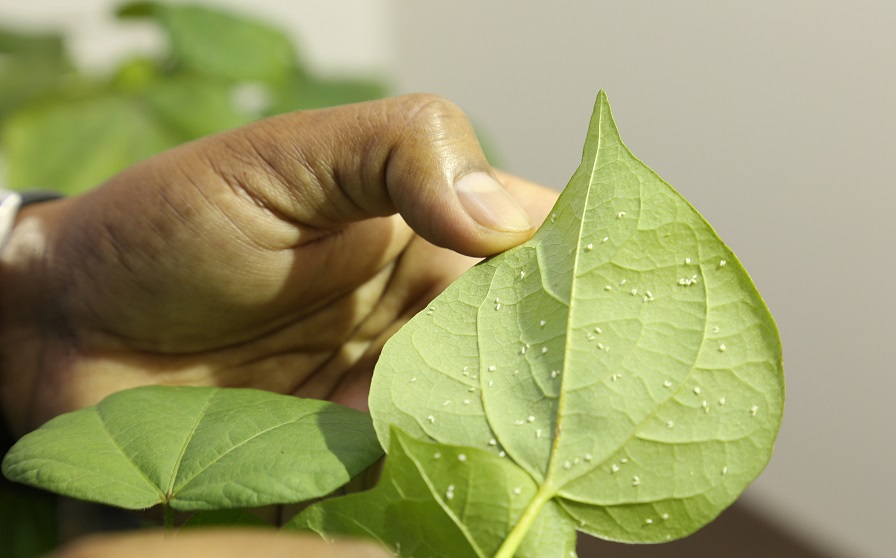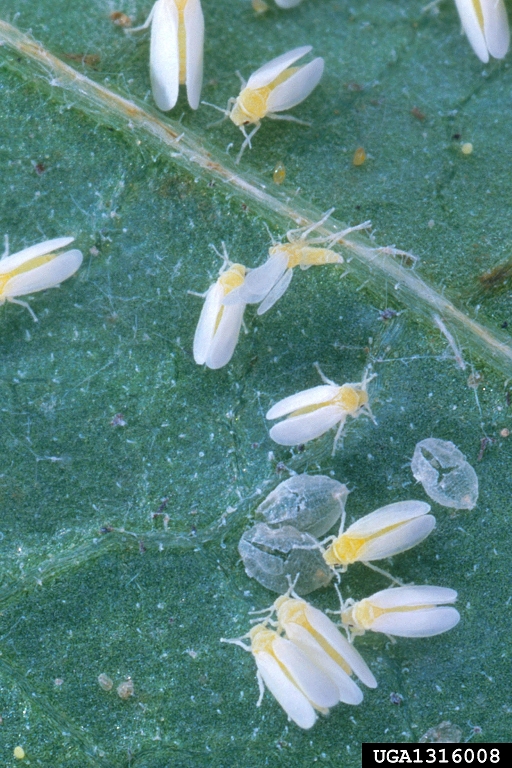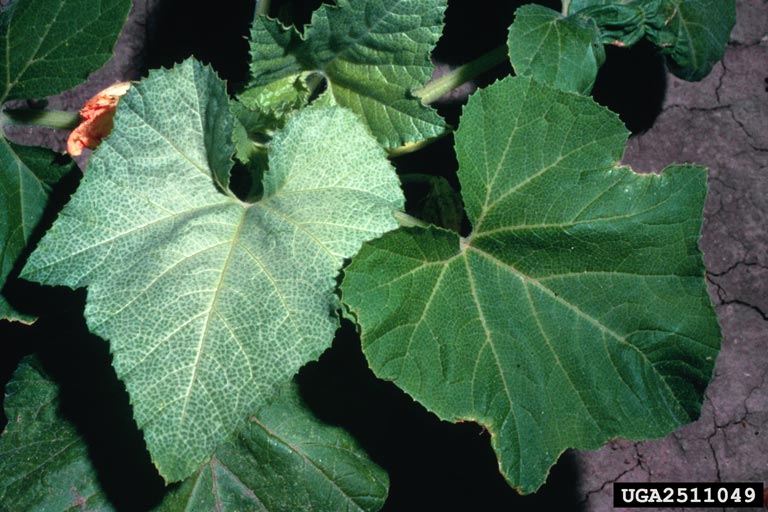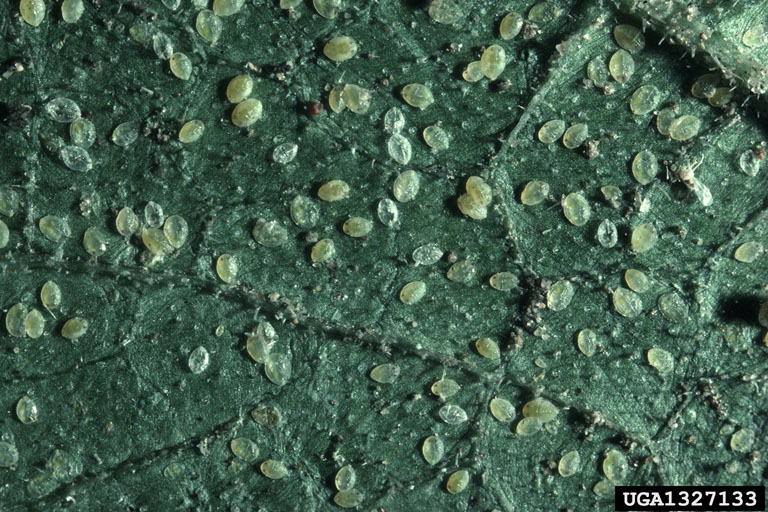Written by: Emily Cabrera, UGA IPM Communications Coordinator
Expert Source: Phillip Roberts, Extension Cotton Entomologist

As the summer months continue to deliver hot, dry conditions throughout most of the state, growers need to be on the lookout for silverleaf whitefly in cotton and vegetables, University of Georgia Cooperative Extension specialist warns.
“We are most likely going to see a surge in silverleaf whitefly this year, both in terms of population size and range,” said Cotton Extension specialist Phillip Roberts.
Silverleaf whitefly (SLWF), Bemisia tabaci, is an economically significant pest of numerous crops in Georgia, including cotton and a wide variety of vegetables. “In Georgia, we have a particularly difficult time controlling this pest because we essentially have cultivated host plants 12 months of the year,” explained Roberts. “We have spring vegetables, followed by summer cotton, followed by fall and winter vegetables, so they just migrate from crop to crop all year.”

Adult whiteflies are moth-like and covered with a white, waxy powder. A single female can deposit anywhere from 50 to 300 eggs, depending on the temperature and host conditions. Whiteflies have needle-like mouthparts and both immature and adult whiteflies feed on the underside of leaves. Feeding results in reduced plant vigor, wilting and cumulative plant stress that substantially reduces yield. Whiteflies excrete a sugary substance called “honeydew.” Leaves with copious honeydew accumulations support the development of sooty mold, which can lead to declining leaf health and premature defoliation. When cotton bolls are open, honeydew production is especially detrimental to fiber quality because honeydew can make the cotton sticky and affect spinning efficiency. In Georgia, whiteflies do not transmit any pathogens that cause plant diseases in cotton, but they are a serious vector of several viral diseases in vegetable crops.

Roberts explained that due to the mild temperatures we experienced this winter, SLWF populations were able to survive and multiply more rapidly going into spring than in previous years. On average, middle and south Georgia – where most of the state’s cotton and vegetable production takes place – receives about 18 days with below-freezing temperatures during the winter months. However, in 2020, these areas only received six days of temperatures below freezing.
“That means some host plants didn’t die back as they usually do, which allowed SLWF to continue to feed and multiply all winter,” said Roberts. “So, we came into 2020 concerned about this pest and now we’re really concerned because they’ve built rapidly throughout July due to the favorable hot, dry conditions in many areas of the state.”
Warmer temperatures trigger faster development. During summer months in Georgia, SLWF can complete a generation within 14 days. “So, in years with record high temperatures and little rainfall, populations build rapidly in cotton before fall vegetable production begins, which is what we’re already starting to see this year,” Roberts explained.
The range of SLWF dispersal is also a concern this year, as growers are beginning to report incidences of this pest in areas of the state that have historically not been infested.
Roberts recommends cotton growers begin monitoring fields at a minimum of once per week. “The way to scout for this pest is to select the 5th main stem leaf just below the plant terminal. Collect 30 leaves per field, at random. Look at the underside of leaves for nymphs. If you have five or more nymphs on 50% of your leaves, you have an infestation and need to begin managing this pest immediately,” said Roberts. “I can’t stress enough how important it is to make timely applications once an infestation is detected. The growth stage of SLWF is most vulnerable to insecticides at the nymph stage, so if you are too late, control will be incredibly difficult and expensive.”

Two groups of insecticides are recommended for managing SLWF: insect growth regulators (IRGs), and systemic insecticides. “Historically, IRGs have been the backbone of SLWF control, they are somewhat slow-acting but provide excellent residual control, which is why timely application is important,” explained Roberts. “If you are in a situation where timely application wasn’t possible, I suggest you use a contact-systemic insecticide, which will provide fast-acting control, but has much less residual efficacy, so this option quickly becomes expensive as you’ll need to make more applications to gain control over the outbreak.”
| Insecticides | Safety to Beneficials | Control Interval* | Life Stages Affected |
| pyriproxyfen Knack | Excellent | 14-30 days | Eggs & mature nymphs |
| buprofezin Courier | Excellent | 14-30 days | Nymphs |
| acetamiprid Assail, others | Moderate | 14-21 days | All stages |
| flupyradifurone Sivanto | Good | 14-21 days | All stages |
| pyrifluquinazon PQZ | Good | 7-14 days | All stages |
| dinotefuran Venom | Moderate | 7-14 days | All stages |
| spiromesifin Oberon | Good | 14-21 days | Primarily nymphs |
Do not mix broad spectrum insecticides (bifenthrin) with selective insecticides (IGRs) for SLWF control unless a tank- mix is required to control multiple insect pests.
The choice to spray an insecticide should be based solely on whether or not a grower has met or exceeded threshold, as several species of predatory and parasitic insects are present in Georgia cotton that should be preserved as best as possible. “These natural controls are our most economical pest management tools,” said Roberts. “Using organophosphate or pyrethroid insecticides will eliminate natural enemies and flare whitefly populations, so these groups of insecticides should be avoided if possible.”
A number of beneficial organisms in cotton fields are effective in reducing whitefly populations. For example, spiders prey upon whitefly adults, and beneficial insects like bigeyed bugs, lacewing larvae, minute pirate bugs, and lady beetles are common predators of whitefly eggs and immatures. Several species of tiny wasps, including those in the genera Encarsia and Eretmocerus, parasitize immature SLWF. Low-level whitefly populations can be suppressed by natural enemies to the point that no insecticide application is required.
There are a few factors that can increase risk of infestation in cotton, so growers are urged to make small alterations to help reduce chances of an outbreak. Roberts recommends choosing a smooth-leaf variety over hairy-leaf varieties as they are much more susceptible to infestation. “There appears to be a direct correlation of SLWF infestations based on the degree of hairiness,” Roberts said.
Growers should also aim to get cotton planted in April or early May to lower the risk for SLWF problems compared with late May and June planted cotton. Dryland (drought stressed) cotton is also at higher risk for SLWF compared with irrigated (no drought stress) cotton.
Roberts tells growers that “ultimately, managing the hosts of SLWF is the most efficient way of preventing population growth. This means discarding vegetable debris from fields in the spring and cotton in the fall following defoliation and harvest.”
Cotton growers should defoliate and harvest in a timely manner. This will help reduce exposure of cotton to honeydew which can have major impact on fiber and spinning quality of cotton and will help reduce the SLWF population in late summer before vegetable production season begins.
“The annual rotation of susceptible hosts creates a snowball effect of this pest. With each crop, whiteflies continue to reproduce before jumping to the next crop. If we don’t do our best to reduce populations within our respective production systems, the population of whiteflies just continues to get bigger and bigger,” cautioned Roberts. “It doesn’t matter if you’re a cotton grower or a vegetable grower, we have to work together to manage this pest. The more people we have committed to reducing the overall pest population, the easier it will be next season to control.”
For more information on Silverleaf Whitefly management in cotton, see UGA Extension Circular 1184. For more information on cross-commodity management of this pest, see UGA Extension Circular 1141.